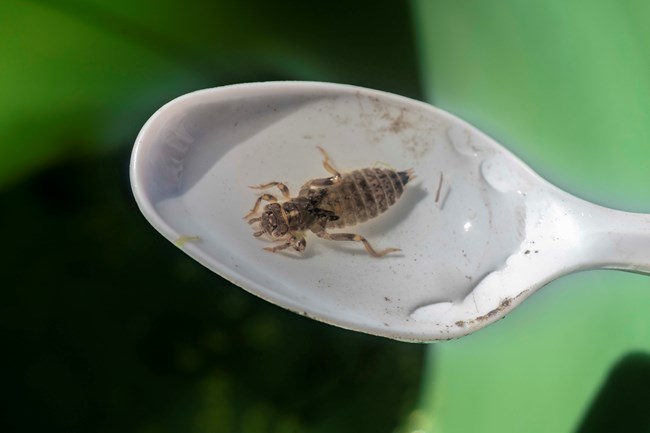Last updated: September 17, 2024
Article
Dragonfly mercury studies uncover unexpected atmospheric delivery pathways

NPS / B. Richards
Scientists have long thought that the main delivery pathway of mercury to remote places like national parks was through rain and snow, called wet deposition. Dry deposition, or the delivery of mercury with particles like dust, was thought to be more prevalent in dry environments, like deserts. However, a new study using mercury stable isotope tracers in dragonfly larvae found surprising results. Most of the mercury in dragonflies from drier regions comes from wet deposition, while dry deposition prevailed in areas with more rainfall and forest cover. These findings present a paradigm shift in our understanding of mercury delivery pathways to waterbodies across ecosystems.
This study analyzed mercury isotopes in dragonfly larvae from 73 national parks across the U.S. The larvae were collected by NPS staff, volunteers, and citizen scientists, as part of the Dragonfly Mercury Project. Mercury isotopes can act like fingerprints to figure out how the mercury enters aquatic food webs.
These findings are important to consider in light of published declines in atmospheric mercury concentrations. These declines have been driven by national and global efforts to reduce mercury usage and release. Researchers predict that sites connected directly to wet deposition in arid locations will respond faster to declines in atmospheric mercury. In contrast, sites more closely tied to dry mercury deposition will likely respond slower. These sites include forested areas where leaves and needles scavenge or filter gaseous mercury out of the air.
Understanding how neurotoxins like mercury move through ecosystems is vital to protecting nationwide resources and human health. Growing research can help predict how mercury exposure in wildlife and humans may change in direct relation to atmospheric mercury declines, as well as climate and land cover changes.
Read more from the paper below.
Geographic Drivers of Mercury Entry into Aquatic Foods Webs Revealed by Mercury Stable Isotopes in Dragonfly Larvae
Abstract
Atmospheric mercury (Hg) emissions and subsequent transport and deposition are major concerns within protected lands, including national parks, where Hg can bioaccumulate to levels detrimental to human and wildlife health. Despite this risk to biological resources, there is limited understanding of the relative importance of different Hg sources and delivery pathways within protected regions. Here, we used Hg stable isotope measurements of a single aquatic bioindicator, dragonfly larvae, to determine if these tracers can resolve spatial patterns in Hg sources, delivery mechanisms, and aquatic cycling at a national scale. Mercury isotope values in dragonfly tissues varied among habitat types (e.g., lentic, lotic, wetland) and geographic location. Photochemical-derived isotope fractionation was habitat-dependent and influenced by factors that impact light penetration directly or indirectly, including dissolved organic matter, canopy cover, and total phosphorus. Strong patterns for Δ200Hg emerged in the western US, highlighting the relative importance of wet deposition sources in arid regions in contrast to dry deposition delivery in forested regions. This work highlights the efficacy of dragonfly larvae as biosentinels for Hg isotope studies due to their ubiquity across freshwater ecosystems and ability to track variation in Hg sources and processing attributed to small-scale habitat and large-scale regional patterns.
Janssen, S.E., C.J. Kotalik, J.J. Willacker, M.T. Tate, C. Flanagan Pritz, S.J. Nelson, D.P. Krabbenhoft, D. Walters, and C. Eagles-Smith. 2024. Geographic Drivers of Mercury Entry into Aquatic Foods Webs Revealed by Mercury Stable Isotopes in Dragonfly Larvae. Environmental Science & Technology. DOI: 10.1021/acs.est.4c02436
Tags
- acadia national park
- allegheny portage railroad national historic site
- amistad national recreation area
- apostle islands national lakeshore
- big bend national park
- big cypress national preserve
- big thicket national preserve
- cape cod national seashore
- capitol reef national park
- channel islands national park
- chickasaw national recreation area
- colorado national monument
- congaree national park
- cuyahoga valley national park
- death valley national park
- delaware water gap national recreation area
- denali national park & preserve
- everglades national park
- gateway national recreation area
- glacier bay national park & preserve
- glen canyon national recreation area
- golden gate national recreation area
- grand canyon national park
- grand portage national monument
- grand teton national park
- great basin national park
- great sand dunes national park & preserve
- great smoky mountains national park
- hawaiʻi volcanoes national park
- homestead national historical park
- hot springs national park
- indiana dunes national park
- isle royale national park
- jean lafitte national historical park and preserve
- john day fossil beds national monument
- katahdin woods and waters national monument
- katmai national park & preserve
- klondike gold rush - seattle unit national historical park
- lake clark national park & preserve
- lassen volcanic national park
- lewis and clark national historical park
- mammoth cave national park
- minute man national historical park
- montezuma castle national monument
- mount rainier national park
- north cascades national park
- olympic national park
- ozark national scenic riverways
- pictured rocks national lakeshore
- puʻukoholā heiau national historic site
- redwood national and state parks
- richmond national battlefield park
- rio grande wild & scenic river
- rock creek park
- rocky mountain national park
- saguaro national park
- saint croix national scenic riverway
- san juan island national historical park
- santa monica mountains national recreation area
- sequoia & kings canyon national parks
- shenandoah national park
- tallgrass prairie national preserve
- timucuan ecological & historic preserve
- upper delaware scenic & recreational river
- valles caldera national preserve
- voyageurs national park
- yellowstone national park
- yosemite national park
- zion national park
- air resources division
- dragonfly mercury project
- citizen science
- community science
- mercury
- air pollution
- park science
- mercury contamination
- wekiva wild and scenic river





